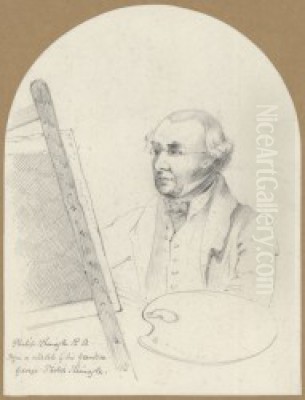
Philip Reinagle RA (1749–1833) stands as a significant, if sometimes overlooked, figure in the landscape of British art during the late 18th and early 19th centuries. An artist of remarkable versatility, Reinagle's extensive oeuvre spanned portraiture, animal painting, landscapes, botanical illustration, and even marine subjects. His career reflects the shifting tastes and burgeoning scientific interests of his era, and his legacy is evident not only in his own diverse body of work but also in the artistic pursuits of his descendants.
Early Life and Artistic Foundations
Born in Edinburgh in 1749, Philip Reinagle's artistic journey began in earnest when he moved to London in 1763. There, he had the distinct advantage of becoming an apprentice to the esteemed Scottish portrait painter Allan Ramsay. Ramsay, then Painter-in-Ordinary to King George III, was a dominant figure in British portraiture, known for his elegant and insightful likenesses. Under Ramsay's tutelage, Reinagle would have received a thorough grounding in the techniques of oil painting, draughtsmanship, and the conventions of aristocratic and royal portraiture.
For several years, Reinagle served as Ramsay's assistant, a role that often involved completing drapery, backgrounds, and producing replicas of his master's portraits. This was a common practice in busy studios of the period, providing invaluable experience for aspiring artists. Indeed, Reinagle's skill was such that he continued to work in Ramsay's studio and even completed some of his master's unfinished commissions after Ramsay's health declined and following his death in 1784. This period undoubtedly honed Reinagle's technical proficiency and his understanding of composition and colour, skills that would serve him well as he diversified his artistic output. His early exposure to the highest echelons of society through Ramsay's clientele also provided him with connections and an understanding of the art market.
A Shift in Focus: From Portraits to Nature's Canvas
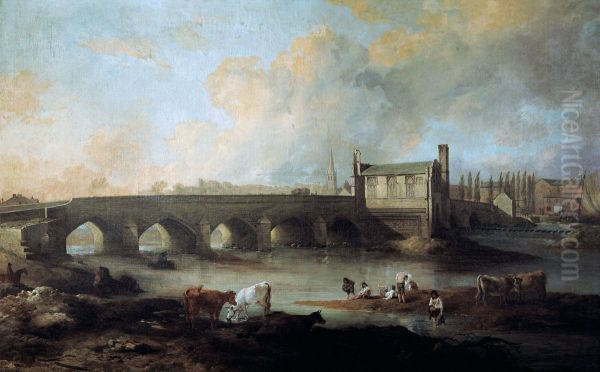
While Reinagle initially established himself by exhibiting portraits at the Royal Academy of Arts starting in 1773, his artistic inclinations began to diverge from the path of pure portraiture. By the late 1770s and early 1780s, a noticeable shift occurred in his subject matter. He increasingly turned his attention towards landscape painting and the depiction of animals, genres that were gaining popularity in Britain, partly influenced by the Romantic movement's emphasis on nature and the picturesque.
This transition was not abrupt but rather a gradual evolution. It's possible that the repetitive nature of studio assistance in portraiture, or perhaps a deeper personal affinity for the natural world, spurred this change. The British countryside, with its varied terrains and atmospheric conditions, offered a rich tapestry for artists. Contemporaries like Thomas Gainsborough, though famed for portraits, also produced evocative landscapes, and the work of earlier masters such as Richard Wilson had laid a foundation for a distinctly British school of landscape painting. Reinagle embraced this, exploring the scenic beauty of various regions.
His foray into animal painting, particularly sporting scenes and depictions of dogs, became a defining feature of his later career. This interest was significantly fostered by his friendship with Colonel Thomas Thornton, a renowned sportsman and patron of the arts. This connection provided Reinagle with ample opportunities to study animals, especially hunting dogs, in their natural element, leading to some of his most dynamic and appreciated works in this genre.
Mastery in Animal Painting
Philip Reinagle's reputation as an animal painter, especially of dogs, grew substantially from the early 19th century onwards. His association with Colonel Thomas Thornton was pivotal. Thornton, an eccentric and avid hunter, commissioned Reinagle to paint his prized hunting dogs, and these works were often reproduced as engravings, further disseminating Reinagle's name and skill. His depictions of spaniels, terriers, and hounds were noted for their anatomical accuracy, vitality, and the ability to capture the individual character of the animals.
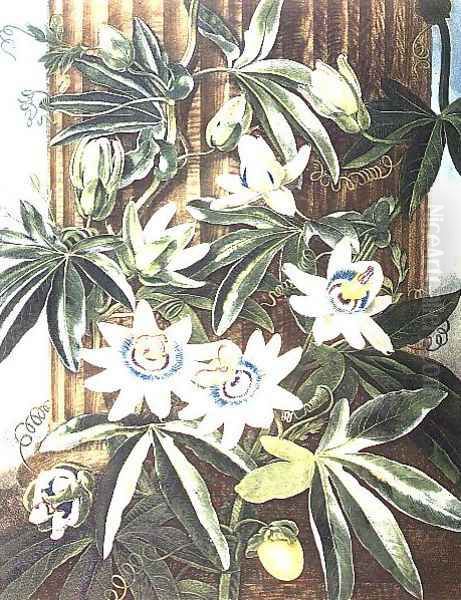
Works such as Fighting Dogs and Fighting Terriers showcase his ability to render animals in dynamic, almost ferocious action, a departure from the more static animal portraiture common at the time. He didn't just paint animals; he captured their spirit and energy. This focus aligned with a growing British fascination with sporting life and the breeding of specific types of dogs, creating a ready market for such pictures. His skill in this area placed him among notable animal painters of the era, a field that included artists like Sawrey Gilpin and, slightly earlier, the incomparable George Stubbs, whose scientific approach to equine anatomy set a high standard.
Reinagle's animal subjects were not limited to domestic creatures. He also produced paintings of birds, sometimes in large, complex compositions. An example is The King Eagle Pursued by a Multitude of Birds to the Sun, a dramatic and imaginative piece. His bird illustrations for George Shaw's Museum Leverianum (also known as the Leverian Museum), a publication cataloguing the extensive natural history collection of Sir Ashton Lever, further demonstrate his ornithological interest and skill. These works required careful observation and a delicate touch to render feathers and avian forms accurately.
Landscapes and the British Scenery
Parallel to his animal painting, Philip Reinagle continued to develop as a landscape artist. He travelled throughout Britain, capturing the diverse scenery of regions such as the Lake District, Snowdonia in Wales, Surrey, and Yorkshire. His landscapes often possess a quiet, pastoral beauty, reflecting the prevailing taste for picturesque views. He was adept at capturing the specific atmospheric effects of the British climate, and his studies of cloud formations, such as A wood scene with cattle - midday effect (circa 1824), reveal a keen observational skill akin to that later famously demonstrated by John Constable.
His landscape Wakefield Bridge and Chantry Chapel (1793), now in The Hepworth Wakefield collection, is a fine example of his topographical work, carefully detailing the architecture and its setting. Such paintings served not only as artistic expressions but also as records of places of interest. Reinagle's landscapes often incorporated animals, seamlessly blending his two main specialities. Cattle, sheep, or deer frequently populate his scenes, adding life and a sense of rustic charm.
The tradition of British landscape painting was rich and evolving during Reinagle's lifetime. Artists like Paul Sandby were pioneering watercolour landscapes and topographical views, while the more dramatic and sublime aspects of nature were beginning to be explored by artists who would pave the way for giants like J.M.W. Turner. Reinagle's work, while perhaps not as revolutionary as Turner's, contributed solidly to the genre, offering well-composed and sensitively rendered views of the British Isles.
Botanical Illustrations: The Temple of Flora
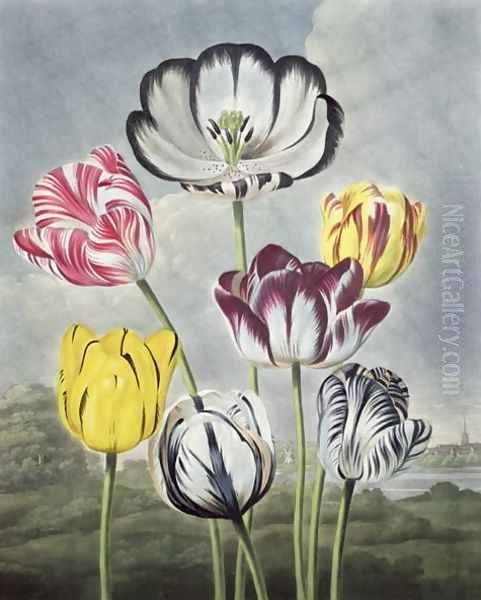
One of Philip Reinagle's most enduring and celebrated achievements lies in his contributions to Dr. Robert John Thornton's ambitious botanical publication, The Temple of Flora (officially New illustration of the sexual system of Carolus von Linnaeus). For this lavish work, published in parts between 1799 and 1807, Reinagle was commissioned to paint thirteen of the flower subjects. These included iconic plates such as The Superb Lily, The Blue Passion Flower, Tulips, The Nodding Renealmia, and The Night-blowing Cereus.
Reinagle's original paintings for The Temple of Flora were then translated into stunning aquatint and mezzotint engravings by various printmakers. His compositions for these plates are notable for their dramatic presentation. Unlike the purely scientific and often decontextualized botanical illustrations of artists like Pierre-Joseph Redouté, Reinagle (under Thornton's direction) placed his flowers in evocative, often romanticized landscape settings, imbuing them with a sense of grandeur and atmosphere. For instance, the Night-blowing Cereus is depicted under a moonlit sky, a detail reportedly painted in collaboration with Peter Charles Henderson, who is credited with the moon in this particular piece.
These illustrations are celebrated for their rich colour, intricate detail, and artistic flair, transcending mere botanical accuracy to become works of art in their own right. The Temple of Flora remains one of the most famous and visually spectacular florilegia ever produced, and Reinagle's contribution was crucial to its success and lasting appeal. His ability to combine botanical precision with artistic sensibility made these images particularly compelling.
Collaborations and Professional Relationships
Throughout his career, Philip Reinagle engaged in various collaborations and navigated the competitive London art world. His work on The Temple of Flora involved close interaction with Dr. Thornton and the numerous engravers who translated his paintings into prints. The previously mentioned collaboration with Peter Charles Henderson on The Night-blowing Cereus highlights a practical aspect of artistic production where specialists might contribute to a single work.
A significant collaborative project involved decorative paintings for Carlton House, the London residence of the Prince Regent (later King George IV). Here, Reinagle worked alongside the decorative painter François Hervé to create four allegorical scenes representing Love, Constancy, Fidelity, and Nature. Such commissions for grand interiors were prestigious and required artists to work within specific architectural and thematic frameworks. This project also brought him into a sphere where he might encounter competition, as other artists like Jiraud le Girardy were also involved in similar decorative schemes at Carlton House during the same period.
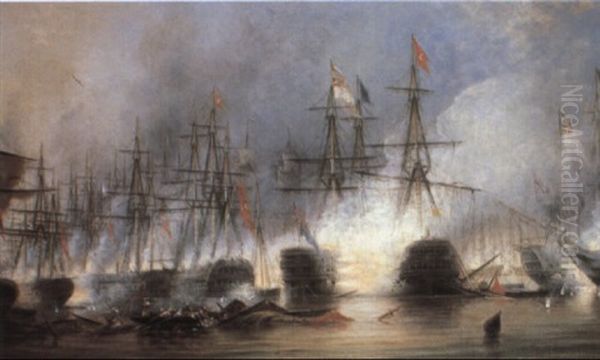
His foundational relationship was, of course, with Allan Ramsay. Beyond the initial apprenticeship, Ramsay's influence likely extended to Reinagle's understanding of patronage and professional conduct. Ramsay also became the godfather to Philip Reinagle's son, Ramsay Richard Reinagle, indicating a lasting personal connection between the families. These relationships – with mentors, patrons, collaborators, and even competitors – were integral to an artist's career in the 18th and 19th centuries, shaping opportunities and professional development.
Marine Art and Historical Subjects
While primarily known for landscapes, animals, and botanical works, Philip Reinagle also ventured into marine painting and historical subjects, further demonstrating his versatility. His marine paintings captured the dynamism of the sea and the intricate details of sailing vessels. This genre was particularly popular in Britain, an island nation with a strong maritime tradition, and artists like Charles Brooking and later Nicholas Pocock specialized in it.
Reinagle produced illustrations depicting the Battle of Navarino (1827), a significant naval engagement. These works required not only an understanding of ships and seascapes but also the ability to convey the drama and complexity of a naval battle. His skill in this area is noteworthy, and it's interesting to observe that marine painting became a strong focus for his nephew (or possibly younger son, sources vary), George Philip Reinagle (1802-1835), who became a distinguished marine artist in his own right, also painting scenes from the Battle of Navarino.
The creation of historical and allegorical paintings, such as those for Carlton House, showed his capacity to work on a grand scale and tackle complex thematic content, moving beyond direct observation of nature to engage with more conceptual and narrative art forms. This breadth of subject matter underscores Reinagle's adaptability and his willingness to meet diverse artistic demands.
Later Years and Royal Academy Involvement
Philip Reinagle's dedication to his art and his standing within the British art community were recognized by his peers. He first exhibited at the Royal Academy of Arts in 1773 and was elected an Associate of the Royal Academy (ARA) in 1787. Full membership as a Royal Academician (RA) followed in 1812, a prestigious honour that signified his established reputation. He continued to exhibit regularly at the Royal Academy throughout his career, showcasing the breadth of his talents.
His involvement with the Royal Academy was a hallmark of a successful artistic career in Britain at the time. The Academy, founded under the patronage of King George III with Sir Joshua Reynolds as its first president, was the principal institution for artistic training and exhibition. Membership conferred status and provided a vital platform for artists to display and sell their work.
Reinagle remained active as a painter into his later years. His long career allowed him to witness significant shifts in artistic styles, from the Rococo elegance of his early mentor Ramsay, through the rise of Neoclassicism and Romanticism, to the burgeoning naturalism of the early Victorian period. He passed away in Chelsea, London, on November 27, 1833, at the venerable age of 84, leaving behind a substantial and varied body of work.
Artistic Style and Techniques
Philip Reinagle's artistic style can be characterized by its blend of detailed realism and a gentle, Romantic sensibility. In his landscapes, he demonstrated a keen eye for the nuances of the British countryside, capturing light, atmosphere, and topographical features with accuracy. His compositions are generally well-balanced and harmonious, often imbued with a serene or picturesque quality. While not as overtly dramatic as some of his Romantic contemporaries like Turner or Caspar David Friedrich on the continent, his landscapes possess an authentic charm and a deep appreciation for nature.
In his animal paintings, particularly of dogs and sporting scenes, Reinagle excelled at conveying movement and vitality. His anatomical understanding, likely honed through careful observation, allowed him to depict animals with convincing realism, whether at rest or in vigorous action. He paid close attention to the texture of fur and feathers, adding to the lifelike quality of his subjects. Artists like George Morland also depicted animals within rural scenes, but Reinagle often gave his animal subjects a more central, portrait-like focus.
His botanical illustrations for The Temple of Flora showcase a meticulous attention to detail combined with an artistic flair for dramatic presentation. The colours are rich and vibrant, and the textures of petals and leaves are rendered with exquisite care. His technique in oil painting was robust, reflecting his classical training under Ramsay, but adaptable to the different demands of portraiture, landscape, and detailed natural history subjects. He was also proficient in watercolour, a medium increasingly popular for landscape and illustrative work.
Legacy and Influence
Philip Reinagle's legacy is multifaceted. He made significant contributions to British landscape and animal painting, genres that were central to the nation's artistic identity. His dog paintings, in particular, remain highly regarded for their verve and accuracy, capturing a specific aspect of British social and sporting life. His work provided a bridge between the more formal traditions of the mid-18th century and the burgeoning Romantic and Naturalistic movements of the early 19th century.
His illustrations for The Temple of Flora are perhaps his most widely recognized achievement internationally, securing his place in the history of botanical art. These images continue to be reproduced and admired for their beauty and artistic merit, influencing how botanical subjects can be presented with both scientific integrity and aesthetic power.
The artistic tradition in the Reinagle family continued through his son, Ramsay Richard Reinagle (1775–1862). Ramsay Richard also became a successful painter, specializing in portraits, landscapes, and animal subjects, and, like his father, was elected a Royal Academician. This familial continuation of artistic practice underscores the environment of creativity that Philip Reinagle fostered. While perhaps not always enjoying the same level of fame as some of his more revolutionary contemporaries, Philip Reinagle's consistent quality, versatility, and significant contributions across several genres ensure his importance in the narrative of British art. His works are held in numerous public and private collections, attesting to his enduring appeal and historical significance.
Conclusion
Philip Reinagle RA was an artist of considerable talent and remarkable adaptability. From his early training in the esteemed studio of Allan Ramsay to his mature work as a painter of landscapes, animals, and exquisite botanical subjects, he navigated the evolving artistic landscape of Georgian and Regency Britain with skill and dedication. His contributions to works like The Temple of Flora, his dynamic animal portraits, and his sensitive depictions of the British countryside have secured his place as a noteworthy figure. His long and productive career left an indelible mark on British art, reflecting the era's diverse interests and leaving a rich legacy for future generations to appreciate.